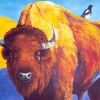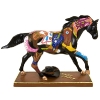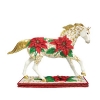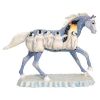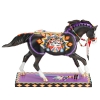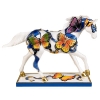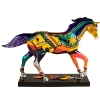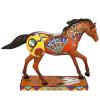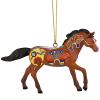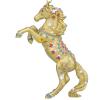
Ryan, Maria
Contemporary Wildlife Artist Saddles Up
Of all the numbers, 7 is seen as the most important, and the luckiest. There are seven days in a week. Seven visible planets. Seven dwarfs. And seven deadly sins. In the game of craps, the dice roll of seven wins.
Seven is a magical number for artist Maria Ryan, too. She was born on March 7. The last two places she lived - Germany and Florida - she spent seven years. It was seven years ago that her painting style underwent a major shift. Seven years after that she painted her first Pony, which to hear her talk about it, has changed her life.
Today, Maria lives in beautiful Coeur d'Alene, Idaho, with a view of a sparkling natural lake and lush pine forests. Visitors outside the windows of her studio include deer, elk, moose, wild turkeys and an occasional black bear cub. It's a dream location at the end of a long and winding road that began in White Plains, New York, where she grew up, with stops in New York City, Washington, D.C., Heidelberg, Germany, and Tampa, Florida.
Along the way she pursued many interests and businesses, all of which seemed to have a creative element to them. She ran an antique business, refinishing vintage furniture. She owned a catering business ("I love to create in the kitchen.") She was a stock broker for Smith Barney for three years. For a period of time she operated an orchid business. ("I had a large greenhouse with 3,000 orchid plants that I sold and rented to clients."
But all the while, parallel to her business endeavors were her artistic activities and ambitions. After graduating from the Graphic Arts Preparatory School of New York, she received formal art schooling at C.W. Post College. She attended 540 workshop hours at Huntington Fine Arts School in New York, and numerous other workshops in the United States and Europe. This is not to overlook her major research trips to the Everglades, Olympic, Rocky Mountain, Yellowstone and Grand Teton National Parks. Or her stint as an Art Specialist with the US Army in Europe.
The list of accomplishments and awards she received for her art is extensive. Her paintings have been exhibited in art galleries both here and abroad. She has designed for two major tabletop companies in England, producing hard surface placemats and coasters. She also designed coffee mugs for a Hong Kong company, fabrics for a New York company, and greeting cards for a Baltimore company.
It was after she moved to Tampa, Florida and took a 3 month intensive course at the Lowry Park Zoo that she started painting wildlife, which earned her national accolades as a fine artist. Stories about her work were published in U.S. Art and Wildlife Art News magazines, and she was one of the artists featured in "Wildlife Art: 60 contemporary Masters and their Work." Then she was selected into the Top 100 and Top 200 two consecutive years in the prestigious Arts for the Parks national competition.
For many artists, these award-winning achievements would signal the kind of success best protected through repetition. For 30 years she had worked hard to establish a style, and now that it was being recognized it should have become her signature.
But it was a style known as "photographic realism," which relied on photography and was recognized by minute and precise details. And while it was a popular style, the obsession with accuracy seemed to Maria to rob her of the right to artistic interpretation. At a certain point, she'd had enough. "I said, 'I don't want to do this anymore; it's not fun, it's tedious.'"
This breaking point spawned a unique style that blended anatomical correctness with artistic interpretation through the unconventional use of color. She began to portray her animal subjects with vibrant, electrically charged colors in dynamic, bold strokes, applied to give character to each animal. She also began to use negative space in a magical way, surrounding her subjects with a bold glow of color. The eyes of each subject continued to be painted realistically, however, to make each animal have a soul and communicate an emotional connection to the viewer.
The evolution in her style has been good to her both personally ("I feel liberated.") and professionally ("Each new painting seems to be greeted with excitement from my collectors.")
But that was seven years ago, and this past year this courageous artist was inspired to take on a new challenge: painting on three-dimensional surfaces, i.e. painting a Pony. "The transition of my art onto the Ponies was a logical step in my career," she says. "I was born under the Chinese sign of the horse and had my own horse in my early twenties. And my daughter has a show horse farm in Lexington, Kentucky."
Her desire to paint a Pony initially took the form of an entry into the national art competition, "The Native Art of Horse Painting." Her submission was a stunning tribute to that hallmark of cultural expression for Native Americans: adornment with jewelry made of silver and turquoise, beadwork and ceremonial regalia. With its incredible detail and creative use of stones, glass, beads, feathers and special "jewel" paints, "Native Jewel Pony" amazed the judges and was selected as one of the 20 finalists. It was so impressive that it was one of the top vote-getters in the national online voting, and was selected for reproduction as a figurine.
The satisfaction Maria received from the experience of painting her Pony prompted her to want to paint other Ponies, several more of which were so striking in their originality that they have been scheduled for release in future figurine herds.
"What a great ride this has turned into," Maria says. "This is the most fun of all in my art career!"
Her enthusiasm is reciprocated by The Trail of Painted Ponies. We take great pleasure in recognizing and rewarding talented artists such as Maria Ryan by inviting them to join The Trail as Official Painted Pony Artists.
Painted Pony figurines by Maria Ryan:
- The Magical Swan
- Boot Camp
- Penguin Express
- Poinsettia Pony
- Native Jewel Pony
- Kachina Pony
- Earth Angels
- Native Essence
- Christmas Kittens
- Prance to the Music
-
Autumn Cornucopia
-
Wedding Wishes
-
Spirit Bear Pony
- Spirit Bear Pony Ornament
- Golden Jewel Pony
- Golden Jewel Pony Ornament


